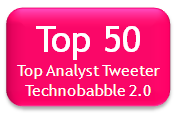This entry was cross-posted from Meanders: The Dow Brook Blog
I attended the AIIM Info360 Conference and Expo last week, in Washington, DC. It was my first AIIM event in 9 years. I had stayed away intentionally, because AIIM and the Enterprise Content Management (ECM) community had stagnated. Business and technology were changing, but the AIIM community remained fixated on things like document capture, storage, output, and archival. Sharing of, and collaborating on, active content was largely ignored.
Lately, I’ve been signs of renewal from AIIM’s leadership and staff, including an active, purposeful embrace of collaboration and social computing as important components of information management. (For example, AIIM published a paper on Systems of Engagement, authored by Geoffrey Moore, in January and a Social Business Roadmap in conjunction with last week’s conference.) So I thought it would be good to attend the event after my long absence, to learn first-hand whether or not change really was occurring in the AIIM community. The verdict:
Parts of the AIIM community remain deeply rooted in the past. The members who are trying to become more current and relevant are so busy talking about business and technology trends that they’ve lost focus on solving specific business problems.
First a word about the part of the community stuck in the past. Wandering the conference show floor made it crystal clear that the majority of the software and hardware vendors present were there to sell to the legacy AIIM crowd. I saw booth after booth touting imaging and other capture hardware and software, management solutions for electronic (and paper!) documents, and industrial-strength printing machines and software. Enough said.
The show floor did include a few vendors addressing the minority of the AIIM community interested in moving toward more lightweight, collaborative content management practices. Included in that group of vendors were Box.net, EMC/Documentum, Microsoft SharePoint, and NewsGator.
One other thought about the show floor: the Web Content Management vendors were noticeably absent. It seems that they’ve moved on from the AIIM community, probably for a variety of reasons. I hope they will come back soon and try again to push the conceptual boundaries of content management in both large organizations and small-to-medium businesses.
The keynote speeches and the few breakout sessions I attended were more visionary than the majority of the exhibits. Keynoters reported on high level trends affecting how businesses create, consume, share and generally manage content. The vendors who had bought keynote spots also presented visions of content management that made their respective, revised market strategies seem irrefutable.
Similarly, most of the breakout sessions I went to presented fairly high level pictures of how content technologies are evolving and where they are (or should be) headed. There were some exceptions, including a session that I co-presented with Dan Levin, COO of Box.net, on current, real-life use cases for mobile content sharing. However, sessions that focused on how the emerging breed of content management practices and supporting technologies can help solve newer (as well as old) business problems were rare.
In short, there were two conferences taking place simultaneously at AIIM/Info360. The first can best be described as representing the status quo. The second can be summed up as follows:
SOCIAL, blah, blah, blah, COLLABORATION, blah, blah, blah, COMMUNITY, blah, blah, blah, ENGAGEMENT, blah, blah, blah, MOBILE, blah, blah, blah, CLOUD, blah, blah, blah, USABILITY, blah, blah, blah…
I applaud the changes that AIIM’s leadership and some forward-thinking members of the community are attempting to make. They have to start by finally acknowledging the macro trends that are occurring, then crafting and articulating a visionary response. This year’s conference did a very good job of that. I hope that by next year, presenters (speakers and exhibitors) at the AIIM show will move beyond the high level messages and discuss how managed sharing of active content can help solve specific business problems and enable organizations to take advantage of tangible opportunities.
 I had the pleasure of moderating a panel, on the subject of coworking, at GigaOM’s Net:Work conference, last week. It was truly a pleasure, because of the experiential diversity and high quality of the panelists.
I had the pleasure of moderating a panel, on the subject of coworking, at GigaOM’s Net:Work conference, last week. It was truly a pleasure, because of the experiential diversity and high quality of the panelists.
 Milestone birthdays customarily spark reflection on the past and future of the celebrant. The
Milestone birthdays customarily spark reflection on the past and future of the celebrant. The 

